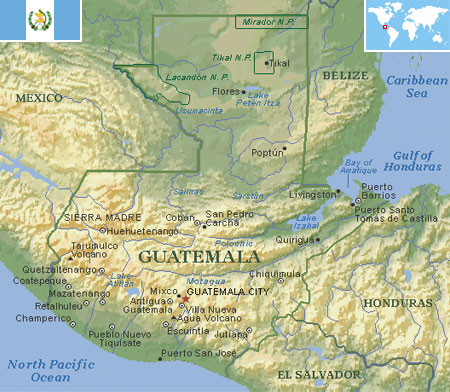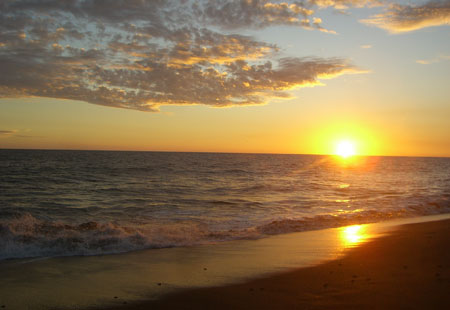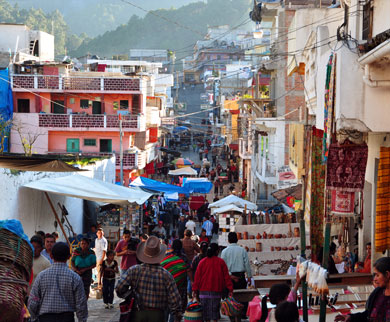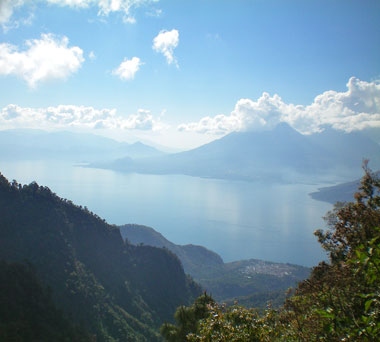Guatemala
Country statistics

Land area: 41,865 sq miles (108,430 sq km)
Total area: 42,042 sq miles (108,890 sq km)
Population (2011 est.): 14,099,032 (growth rate: 1.948%); birth rate: 26.48/1000; infant mortality rate: 25.16/1000; life expectancy: 71.17
Capital City: Guatemala City
Monetary unit: Quetzal
Languages: Spanish 60%, Amerindian languages 40% (23 officially recognized Amerindian languages, including Quiche, Cakchiquel, Kekchi, Mam, Garifuna, and Xinca)
Ethnicity/race: Mestizo (Ladino)-mixed Amerindian-Spanish ancestry-and European 59.4%, K'iche 9.1%, Kaqchikel 8.4%, Mam 7.9%, Q'eqchi 6.3%, other Mayan 8.6%, indigenous non-Mayan 0.2%, other 0.1% (2001)
Religions: Roman Catholic, Protestant, indigenous Mayan beliefs
Country introduction

Guatemala is a country in Central America bordered by Mexico to the north and west, the Pacific Ocean to the south-west, Belize to the north-east, the Caribbean Sea to the east, and Honduras and El Salvador to the south-east.
The Pacific coast is where the majority of the population reside and is mainly a flat, treeless grassland with its mid-region generally watered and fertile. This area was once covered in tropical forest but has since become a rich agricultural area consisting of vast sugarcane and coffee plantations, the latter being on the slopes of the highland zones as they descend into the coastal plain. It is also home to wetlands, mangrove swamps, and beaches of curiously dark color because of their proximity to the country's volcanic chain. In contrast, the Caribbean coastline that runs between the Honduran border and Belize feature white-sand beaches, swamplands, and some impressive tropical rainforests. The terrain becomes lush here and is largely filled with banana plantations. Small mountains are also interspersed throughout parts of the Caribbean coastal region.
Approximately two-thirds of the total land of the country is mountainous, a majority of which are volcanic. The Sierra Madre Mountains are parallel to the Pacific Ocean, extending from east to west, dividing Guatemala into two important regions of unequal portions. The mountain chain here is characterized by steep volcanic cones, including Tajumulco Volcano, which is the highest point in the country and Central America at 4,220 m (13,845 ft). All of Guatemala's 37 volcanoes, which include active volcanoes (Pacaya, Santiaguito, Fuego and Tacaná), are in this mountain chain, and are abundant in the highlands.
The northern region of the country is a broad area around Lake Petén Itzá, that ranges from grazing land to tropical rainforest and is sparsely populated by humans. The jungles of this region are densely populated with a variety of tropical wildlife. It also supplies an abundance of fine wood to the country as well as gum from some trees.
The culture

Guatemalan people are largely mestizo, a mixture of Spanish and Maya blood, while many villagers are direct Maya descendents. Guatemalan history was largely affected by the Maya civilization that lived throughout modern day Guatemala for nearly 600 years before collapsing around 900 AD. The multicultural Guatemalan society has directly influenced the country's customs, cuisine and people.
Guatemalan cuisine varies depending on the region. However, many traditional Guatemalan foods are based on Maya cuisine, predominantly featuring ingredients like corn, chilies and beans. The principal crop of the Maya was corn maize which continues to be very important today. Other popular dishes in Guatemala include enchiladas, quesadillas and tamales, although these are not to be confused with their Mexican counterparts.
Another important part of Guatemalan culture is its music and fashion. Guatemalan people are known for their percussion bands featuring the marimba, the national instrument. Guatemalan fashion is also well known for its use of brightly colored yarn-textiles, capes, shirts, blouses, skirts and dresses. This is another reflection of Guatemalan history as bright colored fabrics were very popular with the Maya people.
Attractions & landmarks

Guatemala is mostly known as the home of the ancient Mayan civilization. In addition to its historical sites, Guatemala boasts some of the world's best hiking, mountain biking and nature spots.
The Mayan civilization prospered for five centuries and erected many cities that stretched across what are today parts of Mexico, Belize, Honduras and Guatemala. Naturally, exploring the Mayan ruins is the main attraction for visitors who come to Guatemala. In the sparcely populated, and somewhat wild northern jungles of the Petén region there are hidden remains of Tikal and El Mirador, both considered the greatest pre-Columbian cities built in the Americas.
The Chichicastenango Market is well known for its famous market days on Thursdays and Sundays and is easily among the more popular Guatemala attractions. The market sells handicrafts and other immaculate hand-made products as well as food, medicine and household goods. In the central part of the market plaza are small eateries (comedores). Among other items sold are textiles, particularly women blouses. The manufacture of masks, used by dancers in traditional dances, such as the Dance of the Conquest, have also made the city well known.
The capital, Guatemala City is a fun and exciting place to visit and there is alot of fascinating history and culture to explore. The city is decorated with beautiful colonial architecture and has many churches scattered around the downtown center, which make the area exquisite. There are also various museums that can be visited, including the Ixchel Museum of Traditional Costumes, which has a wide variety of traditional Guatemalan dress and artistry on display. Another great museum is the Popol Vuh Museum, which has many artifacts from the Mayan period. The Archaeology and Ethnology Museum is worth visiting to get an overview of Guatemala's history, and across the street there is the Museum of Modern Art. Other places that are worth visiting include the Guatemalan City Zoo, the Aurora Zoo, Torre del Reformador which is a tower, the Botanical Gardens and the Railway Museum. Also, to see more ruins of a Mayan city, a trip to Kaminal Juyú is highly recommended.

Lake Atitlán is probably the most beautiful and scenic attraction in Guatemala, which is further enhanced by the surrounding volcanoes that reach over 1,524 m (5,000 ft) above sea level. Along the southern shore of Lake Atitlán rests the tourist village of Panajachel. Among the Panajachel hotels and the city's array of fine eateries, travelers will also be able to enjoy activities such as scuba diving, kayaking, biking and boat tours. Close to the lake is Pacaya volcano, which is considered to be one of the most climbed volcanoes in Guatemala. Rising to an altitude of 2,552 m (8,373 ft), the Pacaya volcano has been continually active since 1965. A hike to the top of the volcano will reward visitors with an amazing panoramic view of the surrounding areas and a chance to peer inside its cone.
While Guatemala is not among the most mentioned places to go beach hunting, along the country's Pacific coast there are plenty of relaxing seaside stretches that offer relaxation and wonderful sunsets. Often not mentioned, but some of these Pacific beaches also feature black sand that were the result of the country's volcanic countryside. Monterrico is the best known of Guatemala beaches, and spending at least a day there is a worthy addition to the list of things to do in Guatemala.